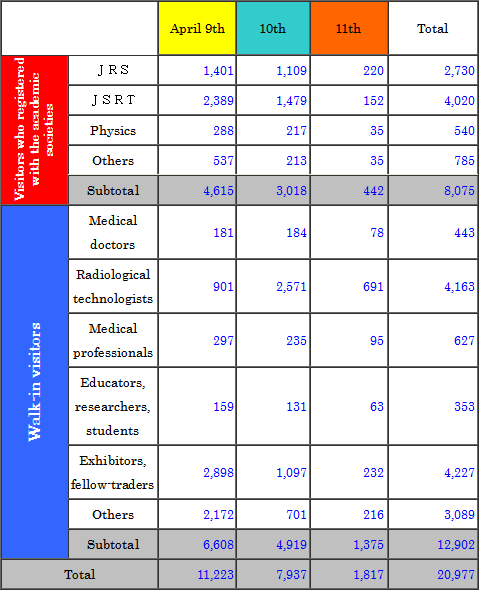 |
|
| October 2010 No. 65 | |
International Exhibition WG
|
 |
| Table 1. Trend of number of participants |
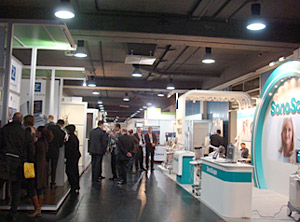 |
| Figure 1. Scene of exhibition |
3. The outline of JIRA booth
This time, JIRA participated in ECR for the first time, and our booth was at the JAPAN pavilion with assistance from JETRO. This is the second exhibition at the Japan pavilion with assistance from JETRO, following RSNA, and marks a milestone for JIRA international exhibition activity.
Exhibition companies: six companies exhibited their devices.
Orion Electric Co., Ltd. ViewSend Co, Ltd.
Mitaya Manufacturing Co., Ltd. Toreck Co., Ltd.
Elquest Co., Ltd. Iken Engineering Co., Ltd.
Booth area: 27 sq m
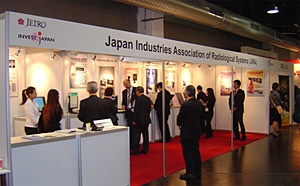 |
| Figure 2. JIRA booth of JAPAN pavilion |
We asked visitors to our JIRA booth to cooperate with the same questionnaire as that for CMEF or RSNA. To the question of occupation, we obtained valid replies (Table 2, 77 persons), most of which were medical professionals, being followed by medical device
dealers. To the question of nationality, we obtained valid replies (Table 3, 121 persons), half of which were Europeans, being followed by East European, African, Middle Eastern and West Asian. This was the same impression as in the whole exhibition.
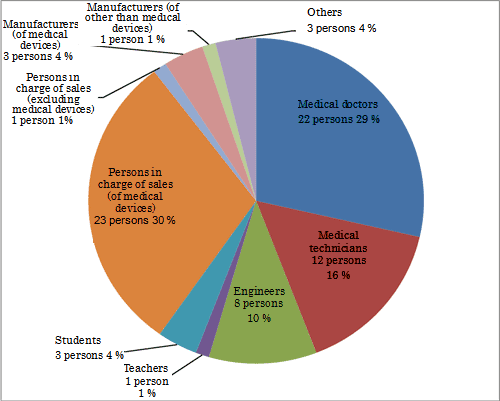 |
| Table 2. Occupation of visitors to JIRA booth |
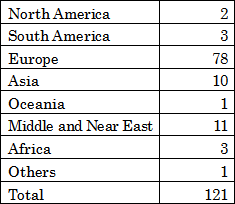 |
| Table 3. Nationality of visitors to JIRA booth |
4. Visit to the JETRO Wien Center
We visited the JETRO Wien Center during the period of exhibition, and were given information about the economy of Central and East Europe. We explained JIRA's international exhibition activity, and how JIRA supports member companies in their exports. It was a fruitful meeting.
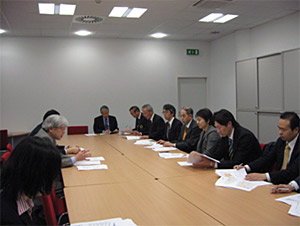 |
| Figure 3. Meeting at JETRO Wien Center |
5. Future challenges
The JIRA exhibition at ECR follows those in China and the U.S. As we have repeated exhibitions, the positive effects of exhibitions have increased. Also in future, we intend to develop public relation activities for JIRA and member companies. Moreover, we think that the exhibition at the JAPAN pavilion with assistance from JETRO made JIRA better known to visitors and that it served as a stimulant to other industrial associations.
International Exhibition WG
JIRA booth exhibition at the 63rd CMEF
(Spring fair in Shenzhen City)
1. Outline of the 63rd CMEF
Period: From 18 to 21 April 2010
Venue: Shenzhen Convention & Exhibition Center
Total exhibition area: 110,000 sq m
Number of exhibition companies/organizations: 2,100 or more
Number of booths: 5,000 or more
Total number of visitors: 65,000 persons or more (from 100 or more nations)
The China International Medical Equipment Fair (CMEF) is the largest medical exhibition in Asia. Since 1979, it has been held twice a year (spring and autumn) by the sponsorship of China Association for the Medical Devices Industry (CAMDI). This is the 6th JIRA participation after its participation in the 61st CMEF (spring) in Shenzhen. Reed Sinopharm Exhibition Co., Ltd. (henceforth, Reed), which plans CMEF, has gradually improved the layout of exhibition area. Last year, Reed opened the pavilion for companies specialized in IVD (In Vitro Diagnostic). This year, Reed newly opened the pavilion for companies related to IT and imaging.
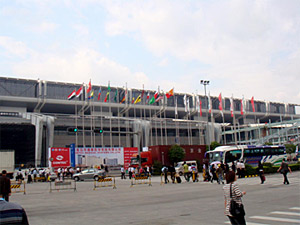 |
| Figure 1. Exhibition site appearance |
2. The outline of JIRA booth
Exhibition companies:
Four companies exhibited their devices.
Toreck Co., Ltd. Orion Electric Co., Ltd.
ViewSend Co, Ltd. Mitaya Manufacturing Co., Ltd.
Booth area: 54 sq m
Booth location: The JAPAN pavilion in the international exhibition zone
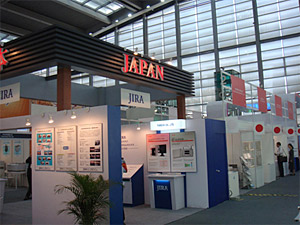 |
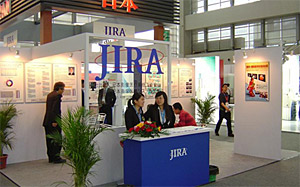 |
| Figure 2. JIRA booth and JAPAN pavilion | Figure 3. JIRA booth |
Products of member companies and some introduction panels, JIRA introduction, the international activity introduction, the ITEM outline introduction and the ITEM 2010 introduction, were displayed in our JIRA booth which was placed at the Japanese Village in the international pavilion.
Furthermore, we distributed leaflets in Chinese, the JIRA member list, brochures for each exhibition company, and giveaways. We distributed questionnaires to ask visitors several questions, such as how much they are interested in JIRA's activity. We expect that the questionnaire will make future exhibitions more effective.
The respondents to the questionnaire were mostly medical device sales persons from the local agents. The breakdown of visitors showed that medical professionals were outnumbered by medical device dealers and manufacturers. This trend was shown also at the JIRA booth.
3. Future challenges
This time, the visitors to the JIRA booth brought many concrete business talks. They were mostly dealers in China. Some of them came from agents in West Asia and Middle and Near East.
In order to convert these inquiries into transactions in future, JIRA must provide more information about medical device regulation in each county, and exhibition companies have to make more sales effort.
From the repeated participation in international exhibitions, the JIRA booth has become better known, and enquires from the booth visitors have increased. In order to further accelerate the global business expansion of exhibition companies in future, each company must select the sales channel that is appropriate to the company and get clearance for medical device regulations of each country.
International Division
Report on periodic exchange meetings with medical equipment related organizations of Republic of Korea
Introduction
From March 20 through 25, 2009, the International Division members visited Korea Food and Drug Administration (KFDA), Korea Testing Laboratory (KTL), Korea Medical Devices Industry Association(KMDIA) and Korea Medical Devices Industrial Cooperative Association (KMDICA), and surveyed Korean medical devices regulations and medical devices market. The members also visited the Korea International Medical, Clinical, Laboratories & Hospital Equipment Show (KIMES 2010) and surveyed the situation of the medical equipment industry.
1. Periodic exchange meeting with Korea Food and Drug Administration (KFDA)
(1) Change in the organization of KFDA
The organization of KFDA has changed with the Medical Devices Safety Bureau re-organized as shown below. Furthermore, the Food and Drug Safety Evaluation Institute has been newly established.
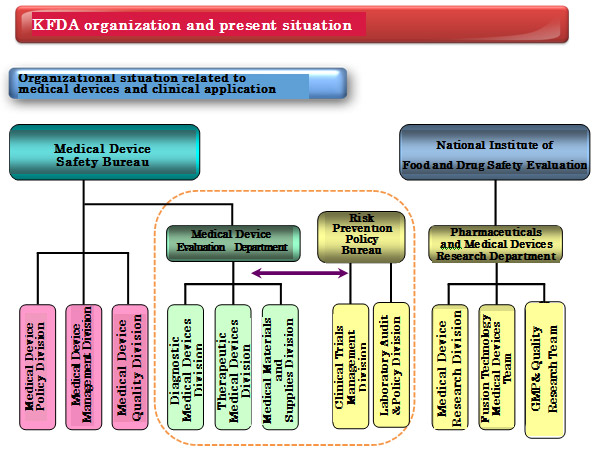 |
(2) Revision of Medical Devices Act/Rules
They are preparing to significantly revise Medial Devices Act in 2010, and they plan to sequentially revise the related rules after the revised Medical Devices Act is established.
(3) Examination of simple technical documents
KFDA has been examining simple technical documents. But, after July this year, a trial test is being performed of a plan to delegate examination of Class 2 medical equipment to a private sector.
(4) The software standards
KFDA recommends referral to the software examination guidelines published by KFDA. But, we can refer to the IEC standards, such as IEC 62304 or IEC 60601-1-4. A general-purpose computer can use the software for medical purposes, but another safety standard is applied in that case.
(5) Responsibility for remote maintenance
When performing remote maintenance, we are required to apply for repair business registration, and to appoint a responsible manager (a responsible engineer).
(6) Application by electronic government
Each time an item license is applied for as public administrative information, they search and cross-check the corporation registration book.
Now, about 95% of applications are electronically processed.
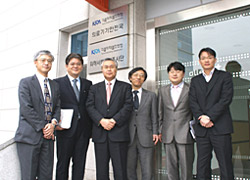 |
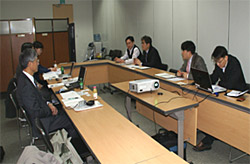 |
| The participating members at the meeting with KFDA |
The exchange meeting with KFDA |
2. The Periodic exchange meeting with the Korea Medical Devices Industry Association(KMDIA)
(1) Organization and action policy
After the general meeting in February this year, the main medical equipment manufacturers joined KMDIA, and the number of member companies reached 660. KMDIA has 30 officers. A half of them comes from manufacturers. A quarter of them are importers. Another quarter is local representatives of foreign companies. They newly established the following two organizations.
1. Medical Equipment Policy Research Institute: It support policies and survey market, etc.
2. Medical Equipment Education Institute: It carries out education relevant to medical equipment (including management).
One of the important action policies for this year is to draft the fair trade agreement of medical equipment.
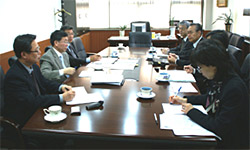 |
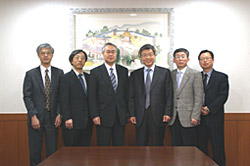 |
| The exchange meeting with KMDIA | The participating members at the meeting with KMDIA |
3. The Periodic exchange meeting with the Korea Testing Laboratory (KTL)
(1) Organization of KTL
The Medical Device Group moved from the Green & Environmental Industry Division to the Digital Industry Division. The Medical Device Group includes the following three centers.
- Medical Device Evaluation center (work content: examination of medical equipment and radiological equipment)
- Medical Device Technology center (work content: support of companies through policy/technical development)
- Medical Supplies Evaluation center (work content: evaluation of implant apparatus, animal experimentation)
(2) Examination of simple technical documents
After July this year, KTL starts examination of some items under delegation from KFDA. The items to be handled are some Class 2 equipment, such as a sphygmomanometer, simple ultrasonic diagnostic equipment, etc.
(3) Laws related with other organizations than KFDA.
The following two laws also apply to medical equipment.
1. The Rational Energy Utilization Act of the Republic of Korea is related to energy use (rules for efficiency control machines and materials etc.). Its related projects are driven mainly by the Korea Energy Management Corporation.
2. The Act for Resource Recycling of Electrical and Electronic Equipment and Vehicles (corresponding to RoHS regulation) is handled mainly with the Korea Electronics Association
.
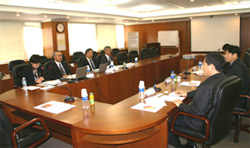 |
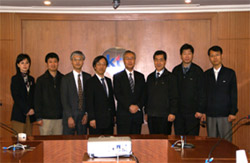 |
| The exchange meeting with KTL | The participating members at the meeting with KTL |
4. The Periodic exchange meeting with the Korea Medical Devices Industrial Coop. Association (KMDICA)
(1) Organization and activity
The number of member companies increased from 324 to 352. They newly organized the Education Development Team and the Research Development Team, and they conduct seminars to manufacturers. They relay manufacturers' requests to KFDA, or help manufacturers to join an exhibition.
Korea has an industry-specific sector counseling system that develops human resources in industries. This system designates KMDICA as an educational organization for medical equipment industry.
(2) Rational Energy Utilization Act of the Republic of Korea
This law was drafted by Ministry of Knowledge Economy. It requires reduction of standby power consumption, and applies to monitors, printers and PCs. A penalty is provided for violation. Procedures are handled by the Korea Energy Management Corporation.
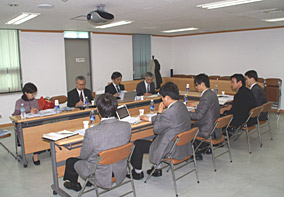 |
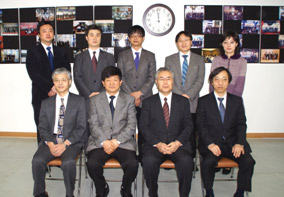 |
| The exchange meeting with KMDICA | The participating members at the meeting with KMDICA |
5. Korean medical equipment market
| Change of scale of Korean medical equipment market |
 |
In 2008, the production reached about 2,500 billion won, including the export of 1,200 billion won. The domestic shipment was 1,300 billion won. The market size was 3,600 billion won.
The increase percentages over the last year were 16% for production, 30% for export, 17% for import, and 11% for domestic market. KMDIA attributes the market growth to the aging society and to higher health awareness.
6. KIMES 2010
The period was from March 18 through 21, with 1,045 participating companies and 57,054 visitors.
The themes were Better Health, Better Life, higher health awareness reflecting the external environment of the aging society, and KIMES in the World (exhibition joined by every nation towards world medical markets), and globalization.
The exhibition of this year reflects the arrival of the aging society and higher health awareness. The increase percentages over the last year were 10 to 15% for visitors, 4 to 5% for the participating companies, and 10% for booth space. KIMES 2009 was not active because of the recession. However the economy is on the way to recovery this year, resulting in a larger scale of exhibition than in 2009.
Medical Imaging System Division
About the system for quality assurance for images
1. The system for quality assurance for images
In Japan, medical institutions are increasingly introducing PACS (Picture Archiving and Communication Systems = medical image management / reference system through the network) toward filmless operation. The system for quality assurance for images is an important system for quality assurance for images and relevant information to ensure "image quality check" and "reconciliation of order content and image" as quality assurance of various medical images stored in PACS.
Also in the film operation age, the image quality check was a basis factor. In line with popularity of filmless operation, the volume of image information has dramatically increased (Slice War). In order to ensure reconciliation of image and information, we recognize again that systematization of quality assurance for images and relevant information is necessary and important.
| To ensure reconciliation of images and patient/examination information (Large Image) |
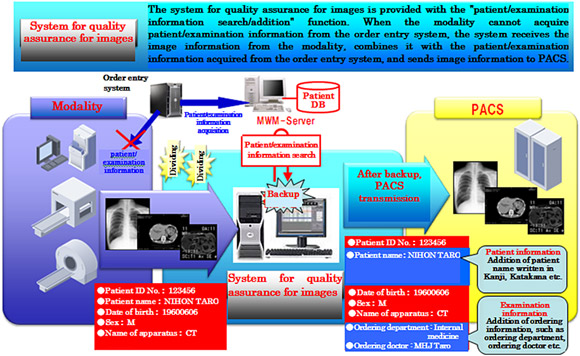 |
Moreover, the functions of the system for quality assurance for images include registration/ modification of study series, sorting/coupling, and confirmation/ modification of patient information. These functions are used to define and pattern images so that they are easy to be handled. As a result, it improves the work efficiency of the entire radiology department, and reduces the work burden of image reading doctors.
2. Lecture meeting in JIRA
Thus, we recognize that the system for quality assurance for images is important. Opinions divide, however, about the system definition and scope, necessary functions and system configuration (Standalone, with PACS, with RIS, etc.), also among the related academic societies. JIRA held lecture meetings mainly for development engineers in JIRA member companies, where the leading users presented their experience and comments about their system for quality assurance for images. The meetings were held twice, in March, 2009 and March, 2010.
The first meeting was held on March 12, 2009 in the JIRA conference room according to the following program almost to schedule.
| 13:30-13:35 | Opening remarks JIRA Medical Imaging System Division, CyberRad Committee Yutaka Yamamoto |
| 13:35-14:35 | Subject 1: "Consideration of quality assurance for images" Okazaki City Hospital Yasuo Okuda, RT |
| 14:35-15:35 | Subject 2: "The practicality of the multifunctional quality assurance for images (QA-Station)" Kitasato University Kitasato Institute Medical Center Hospital Satoshi Yanagita, RT |
| 15:35-15:45 | Break |
| 15:45-16:45 | Subject 3: "New style for the quality assurance for images (check and verification) towards filmless environment" Osaka Medical College Hospital Motofumi Ishiura, RT |
| 16:45-17:00 | Q&A on all subjects |
The second meeting was held on March 11, 2010 at JIRA conference room according to the following program almost to schedule in order to further explore the first meeting.
| 13:30-13:35 | Opening-remarks JIRA Medical Imaging System Division, System PR Committee Yutaka Yamamoto |
| 13:35-14:35 | Subject 1: Guideline on confirmation and saving of image information Okazaki City Hospital Yasuo Okuda, RT |
| 14:35-15:35 | Subject 2: Roles of the system for quality assurance for images and radiology information system (RIS) Yamaguchi University Hospital Hideyuki Iwanaga, RT |
| 15:35-15:45 | Break |
| 15:45-16:45 | Subject 3 : The necessity, adjustment, limit and clinical application for the system for quality assurance for images Showa University Northern Yokohama Hospital Masaru Nitta, RT |
| 16:45-17:00 | Q&A on all subjects: joined by all the lecturers MC (JIRA Medical Image System Division, DICOM Committee Chairman Makoto Suzuki). |
Both lecture meetings were joined by 40 persons (capacity). Nobody left the room during the meeting. The meetings were successful. The Q&A session was active with hot discussion.
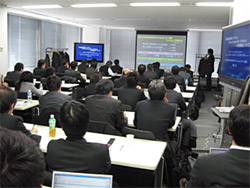 |
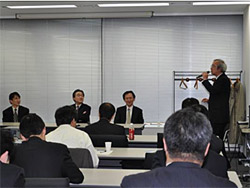 |
| Photo.1 Scene of meeting filled to capacity | Photo.2 Lecturers during Q&A session |
3. Points of lectures
Lecturers explained the requirements for the system for quality assurance for images toward realization of filmless system, and showed examples.
According to the lecturers, the Japanese guidelines, about the confirmation of image information, state that the quality assurance for images does not need special equipment and application software, but requires balanced operation between technology and administration. This is the basis of image confirmation and creation responsibility,
Their explanation covered the experience and system configuration for actual image operation, as well as the functions needed by the system for quality assurance for images and the future prospects.
Users have diverse requests for the system for quality assurance for images. While the details of the contents of lectures are not mentioned herein, the meetings gave the audience advance knowledge of the guidelines of the Japanese unique system of image information confirmation, which will be released in future. The audience got much from the meetings.
4. Future development
In order to widely popularize the filmless operation, the system for quality assurance for images is becoming increasingly important and accordingly must be efficient, labor-saving and simple through, for example, collaboration with RIS (Radiology Information System = information system of radiology department) and the automatic functions to divide/combine series and sort images according to the reading procedure.
In future, the system is not limited to radiological imaging equipment. We expect diversified requests from other imaging modalities and clinical laboratories. In the second lecture meeting, the advanced researches in this direction were announced.
Furthermore, we expect that the concept of the system for quality assurance for images will improve quality of information and increase efficiency across the entire hospital through collaboration with HIS (Hospital Information System) and realization of the systematic operation through standard workflow.



